
Christiaan Hendrik Persoon was a German mycologist who made additions to Linnaeus' mushroom taxonomy.

Drosera, which is commonly known as the sundews, is one of the largest genera of carnivorous plants, with at least 194 species. These members of the family Droseraceae lure, capture, and digest insects using stalked mucilaginous glands covering their leaf surfaces. The insects are used to supplement the poor mineral nutrition of the soil in which the plants grow. Various species, which vary greatly in size and form, are native to every continent except Antarctica.

Phaseolus is a genus of herbaceous to woody annual and perennial vines in the family Fabaceae containing about 70 plant species, all native to the Americas, primarily Mesoamerica.
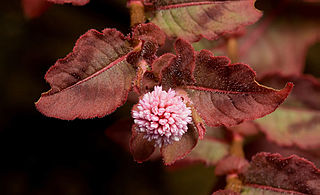
Persicaria is a genus of herbaceous flowering plants in the knotweed family, Polygonaceae. Plants of the genus are known commonly as knotweeds or smartweeds. It has a cosmopolitan distribution, with species occurring nearly worldwide. The genus was segregated from Polygonum.
Harold Ernest Robinson was an American botanist and entomologist.

Carl Johan Fredrik Skottsberg was a Swedish botanist and explorer of Antarctica.

Cassytha is a genus of some two dozen species of obligately parasitic vines in the family Lauraceae. Superficially, and in some aspects of their ecology, they closely resemble plants in the unrelated genus Cuscuta, the dodders. When fruit and flowers are absent in the field, the physical resemblance is so close that few people without technical training can discern the difference. In this respect and in their ecology the two genera present a spectacular example of convergent evolution. Nonetheless, Nickrent comments that "Cassytha is uneqivocally assigned to Lauraceae based on (both) morphological and molecular data." In its divergence from habits typical of the Lauraceae, Cassytha also presents examples of mosaic evolution
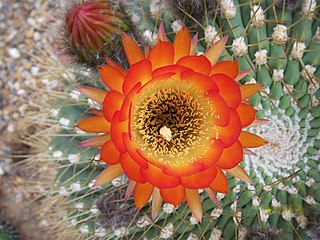
Soehrensia is a large genus of cacti native to South America.

Lechenaultia is a genus of flowering plants in the family Goodeniaceae, the species native to Australia with one species also occurring in New Guinea. Plants in the genus Lechenaultia are glabrous shrubs or herbs with needle-shaped leaves, more or less sessile flowers with five sepals and five blue, white, or yellow and red petals in two unequal lobes, the fruit an elongated capsule.

Lessonia is a genus of large kelp native to the southern Pacific Ocean. It is restricted to the southern hemisphere and is distributed along the coasts of South America, New Zealand, Tasmania, and the Antarctic islands. The genus was first described by Jean Baptiste Bory de Saint-Vincent in 1825.

Loreleia is a genus of brightly colored agarics in the Hymenochaetales that have an omphalinoid morphology. They inhabit mosses and or liverworts on soil in temperate regions of the Northern Hemisphere. Phylogenetically related agarics are in the genera Contumyces, Gyroflexus, Rickenella, Cantharellopsis and Blasiphalia, as well as the stipitate-stereoid genera Muscinupta and Cotylidia and the clavaroid genus, Alloclavaria. However, the large number of DNA base-pair changes causes a long-branch to form in phylogenetic analyses depicted as cladograms.
Thomandersia is the sole genus in the Thomandersiaceae, an African family of flowering plants. Thomandersia is a genus of shrubs and small trees, with six species native to Central and West Africa.

Ruhlandiella is a genus of fungi within the family Pezizaceae. Ruhlandiella species are exothecial hypogeous fungi, which are essentially truffles that lack the outer layer or peridium. Ruhlandiella species are widely distributed in Nothofagaceae forests in South America and near Eucalyptus or Melaleuca plants in Australia, North America, and Europe.
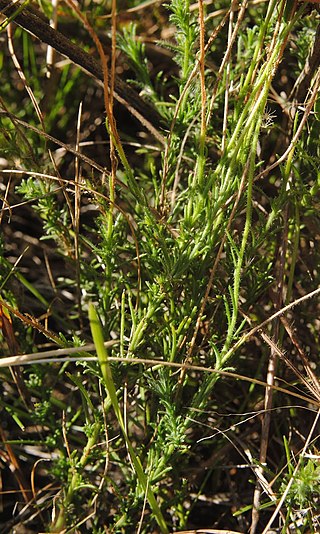
Hysterionica is a genus of flowering plants in the family Asteraceae.
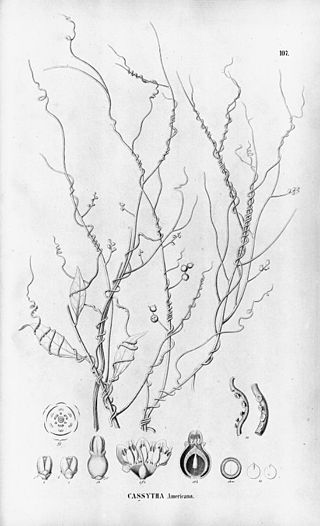
Cassytha filiformis or love-vine is an orangish, wiry, parasitic vine in the laurel family (Lauraceae), found in warm tropical regions worldwide in the Americas, Africa, Asia, Australia, and the Pacific. It is an obligate parasite, meaning it cannot complete its life-cycle without another host plant. Research in Florida has found that love-vine inhibits gall wasps by attacking the galls that the wasps create for their young. The plant is one of many considered an aphrodisiac in the Caribbean, lending the name "love-vine."

The genus Barteria is in the family Passifloraceae in the major group Angiosperms. It contains 8 described species, however, only 6 are accepted.

Meottomyces is a small genus of relatively nondescript, fleshy, brown mushrooms related to Tubaria. In older classifications it had been included in Pholiota, Phaeogalera, or Hemipholiota. Modern molecular evidence suggested recognition of a separate genus when sequences of a collection first identified as Pholiota oedipus, now reclassified in Meottomyces, revealed a unique branch. Subsequently, that species was studied by Holec and later as Phaeogalera oedipus was shown to be distinct from Tubaria but not the type of Phaeogalera itself. Additional phylogenetic support was provided by Gitte Petersen and others, who clearly showed a separation from Phaeogalera. The genus was erected by Vizzini, for two species and two varieties, all former members of Pholiota. Vizzini treated the name Pholiota oedipus as a misapplied name, but this was contested by Legon, who provided detailed notes on the types and ecology of the type species.
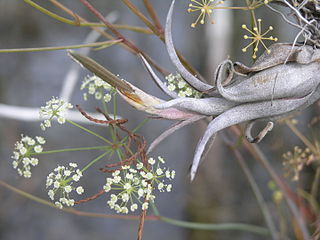
Tiedemannia filiformis is a species of flowering plant in the carrot family known by the common names water cowbane and water dropwort. It grows in swamps, freshwater wetlands, and along the borders of ponds in the southeastern United States, as far north as Delaware, as well as the northern Bahamian pineyards of the Bahamas.

Leptinella filiformis, or slender button daisy, is a species of flowering plant in the daisy family, found only in the north-eastern part of the South Island of New Zealand. Thought to be extinct by the 1980s, it was rediscovered growing on a Hanmer Springs hotel lawn in 1998, and in the wild in 2015.
Henricus (Harrie) Johannes Maria Sipman is a Dutch lichenologist. He specialises in tropical and subtropical lichens, and has authored or co-authored more than 250 scientific publications. He was the curator of the lichen herbarium at the Berlin Botanical Garden and Botanical Museum from 1983 until his retirement in 2010.
















